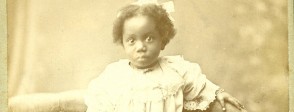Start with the photograph of Amy Barbour-James. Ask students to write a list of questions they have about this image. Open this into a classroom discussion and give answers where relevant. Ask them to compare it with family photographs today – what is similar, what is different? Look also at the photographs of Caroline and John Barbour-James; identify and discuss the ways the family presented themselves.
Visual analysis of photography: look briefly at images from the black Victorians exhibition in For the Classroom. Examine in particular the images by English artists in the early 19th century period to see the how the view of black people was constructed at this time – usually they are servants, or supplicant to Europeans, or the object of scrutiny and fascination. Now look at images in the Black Chronicles online exhibition in For the classroom. Ask pupils to select a photographic portrait or group photograph and analyse first what they can see and what sort of impression this image gives. Then ask them to consider how the image has been constructed – do they think the sitter has chosen this? What do the clothes, pose, expression and props suggest about the person or family. Can they find out more about the sitter and/or the photographic studio?
Campaigning for the rights of black people was fraught with difficulties. Dr Moody, leader of the League of Coloured Peoples, in 1942, innocently identified Amy Barbour-James as from British Guiana on the letterhead even though she was born in Britain and did not visit Guyana until 1950 – see For the classroom. The challenge was to balance rights of being British with different global family heritage links. Discuss with students the challenges that fighting for the rights of an international community in London presents. These include acknowledging the diverse origins of the community, yet keeping it together.
John Barbour-James’s African Patriotic Intelligence Bureau, founded in 1918, set out its aims in its letterhead: “To broadcast the appreciation by the African and African-descended peoples, of their contact with Great Britain, and the mutual benefits thereby conferred; to advocate the reasonable claims for opportunity for all men and women”. Discuss with pupils what ‘patriotic’ means in this context. Look at the language of these aims – think carefully about the terms ‘mutual’ and ‘reasonable’. Bearing in mind that the aims were formulated in 1918, why are these particular terms being used? Why might a more assertive stance be risky? Imagine you were a member of the Bureau; write a speech for a white audience explaining the aims of the Bureau.
Look at the objectives of the League of Coloured Peoples (LCP) as set out on its letterhead – see For the classroom. Compare these with the aims of the African Patriotic Intelligence Bureau. What are the differences? In groups ask students to discuss which of these are short, which medium and which long-term aims. Explain that it is 1942 and Britain and its Empire are at war on many fronts across the world with soldiers of African, Caribbean and Asian descent fundamental to the war effort in many regions. Ask students to imagine that they are developing a campaign for the LCP. How might they start their campaign? Where would the greatest challenges lie? What factors can they take advantage of? See also links in the resources from Black History 4 Schools in For the classroom. After they have presented their campaigns, hold a discussion focusing specifically on the question of loyalty in such campaigns.
Ask students to research the long history of black people in Britain through images. They might start with paintings from the Tudor era or the Zoffany painting of Dido Elizabeth Belle – see For the classroom – and look at prints and then photographs. They could also use some of the objects in A bigger picture. Use a chronological framework to structure their findings. Ask students to choose one image and to explain the scene from that black individual’s point of view. Why are they there, what are they doing, how do they feel?
Using resources from the Black Cultural Archives in For the classroom, find examples of poetry, for example by Paul Laurence Dunbar, music and novels to look further at the cultural lives of black Edwardians and of the black community in the early twentieth century. A comparison study could focus on a similar period in the USA.


